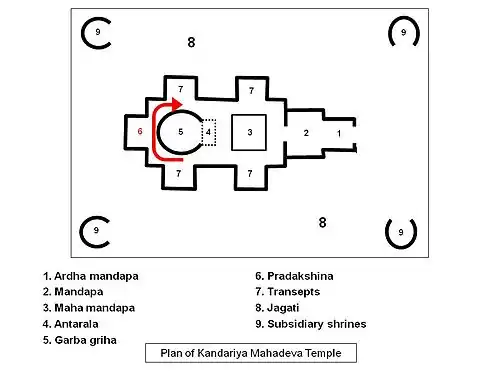Ardhamandapa
In Hindu temple architecture, Ardhamandapa (lit. half-open hall), also spelled artha mandapam or ardh mandapam, is an important element of the entrance group. It is an entrance porch forming a transitional area between the outside and a mandapa of the temple.[1][2]


Overview
Ardhamandapa is usually an open—to provide light and air—four-pillared pavilion in front of the entrance door of mandapa of the temple. If the temple mandapa has three entrance doors, there have to be three such porches, one on each side. Ardhamandapas usually resemble mandapas in design and carving.[3] Most Hindu, Jain, and Buddhist temples feature various transitional spaces between the central shrine (garbhagriha) and the outside world, but only the largest, most developed temples offer the full set of these elements: ardhamandapa, mandapa, and mahamandapa, with the first being the lowest.[4][5][6][7]
References
- Allen, Margaret Prosser (1991). Ornament in Indian Architecture. University of Delaware Press. p. 127. ISBN 9780874133998. Retrieved 28 June 2019.
- "A Visual Glossary of Hindu Architecture". brewminate.com. 2 January 2017. Retrieved 28 June 2019.
- "Ardhamandapa". blessingsonthenet.com. Retrieved 28 June 2019.
- Harshananda, Swami. "Ardha-maṇḍapa". Retrieved 28 June 2019.
- "Khajuraho Architecture". Carthage College. Retrieved 28 June 2019.
- "francofrescura.co.za | Architecture | A glossary of southern african architectural terms". www.sahistory.org.za. Retrieved 28 June 2019.
- Cartwright, Mark (4 September 2015). "Hindu Architecture". Ancient History Encyclopedia. Retrieved 28 June 2019.